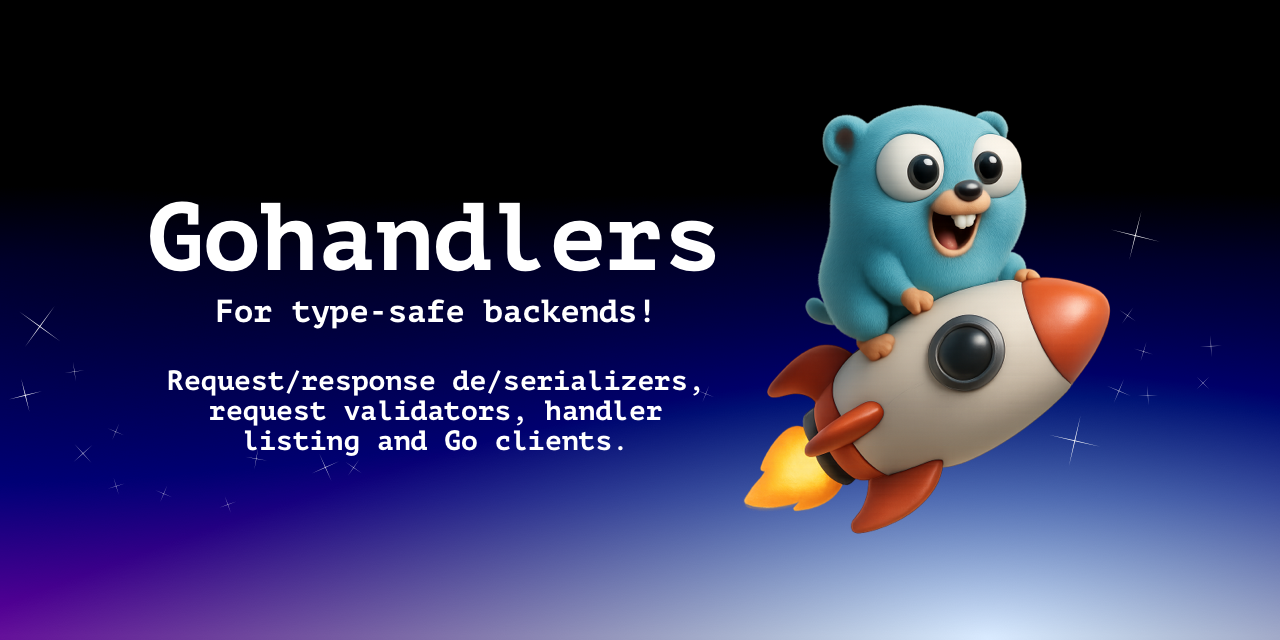Gohandlers

Gohandlers is a CLI tool for Go developers to automate generating type safe and reflectless binding type helpers, endpoint listers and clients for RPC-like use over HTTP without proto.
In short, Gohandlers aims to fill the missing gap in framework-less web development by connecting your handlers, types, and routing in one automated step. This improves API consistency and documentation, since the code itself describes available endpoints, methods, and expected data.
Features
- On binding types:
- Build, parse and validate requests
- Write and parse responses
- Get listers:
- Easy to register all endpoints
- No handlers left unregistered
- Get client code
- Real and mock implementations
- Interface for testing
- RPC-like service-to-service requests
- Route method & paths:
- Inference via handler prefix and binding body
- Override via doc-comments
- Conflict checks
- Enforces on field types:
- Validation methods
- De/serialization methods for query, route and form contexts
- Safety:
- No fields are skipped
- Compile time checks on missing field validators
- Single source of truth for API definition
- Convenience
- Integrate into build system
- Always up-to-date
- Leverage code completion
- No boilerplate
- Keep using the good old:
- net/http for requests/responses
- json encoder for bodies
What you give and get
What you give
A folder with a bunch of Go files each contain binding types and http.HandlerFuncs:
type CreateAccountRequest struct {
Firstname columns.HumanName `json:"firstname"`
Lastname columns.HumanName `json:"lastname"`
Birthday transports.HumanBirthday `json:"birthday"`
Country transports.Country `json:"country"`
RedirectUrl basics.String `query:"redirect"`
}
// POST
func (p *Public) CreateAccount(w http.ResponseWriter, r *http.Request)
What you get
Handler listers:
func ListHandlers() map[string]gohandlers.HandlerInfo
func (pu *Public) ListHandlers() map[string]gohandlers.HandlerInfo
func (pr *Private) ListHandlers() map[string]gohandlers.HandlerInfo
Binding helpers:
// For requests:
func (bq CreateAccountRequest) Build(host string) (*http.Request, error)
func (bq *CreateAccountRequest) Parse(rq *http.Request) error
func (bq CreateAccountRequest) Validate() (issues map[string]any)
// For responses:
func (bs CreateEmailGrantResponse) Write(w http.ResponseWriter) error
func (bs *CreateEmailGrantResponse) Parse(rs *http.Response) error
Client implementation and a mock with methods like:
type Pool interface {
Host() (string, error)
}
type Client struct {
p Pool
}
func (c *Client) CreateAccount(bq *endpoints.CreateAccountRequest) (*http.Response, error)
func (c *Client) CreateEmailGrant(bq *endpoints.CreateEmailGrantRequest) (*endpoints.CreateEmailGrantResponse, error)
func (c *Client) CreatePasswordGrant(bq *endpoints.CreatePasswordGrantRequest) (*endpoints.CreatePasswordGrantResponse, error)
func (c *Client) CreatePhoneGrant(bq *endpoints.CreatePhoneGrantRequest) (*endpoints.CreatePhoneGrantResponse, error)
// for the tests don't need the real deal
type Interface interface {
CreateAccount(*endpoints.CreateAccountRequest) (*http.Response, error)
CreateEmailGrant(*endpoints.CreateEmailGrantRequest) (*endpoints.CreateEmailGrantResponse, error)
CreatePasswordGrant(*endpoints.CreatePasswordGrantRequest) (*endpoints.CreatePasswordGrantResponse, error)
CreatePhoneGrant(*endpoints.CreatePhoneGrantRequest) (*endpoints.CreatePhoneGrantResponse, error)
}
Warnings for inferred, implied and specified endpoint methods:
$ gohandlers helpers -v 1>/dev/null
error: checkmembershipeventual.go:CheckMembershipEventual: assigned "POST" but the request binding type doesn't contain a body
warning: creategroup.go:CreateGroup: handler name implies "POST" but doc comment specifies "GET"
error: creategroup.go:CreateGroup: assigned "GET" but the request binding type contains a body
Visit Petstore
Visit Gohandlers Petstore in Github to see how using Go for backend development looks like when Gohandlers is in use.
Visit repository
Gohandlers is on Github.